WASH News and Stories

Rainwater Checklist
-
School - at a rural primary or secondary school, ranging from 200 to
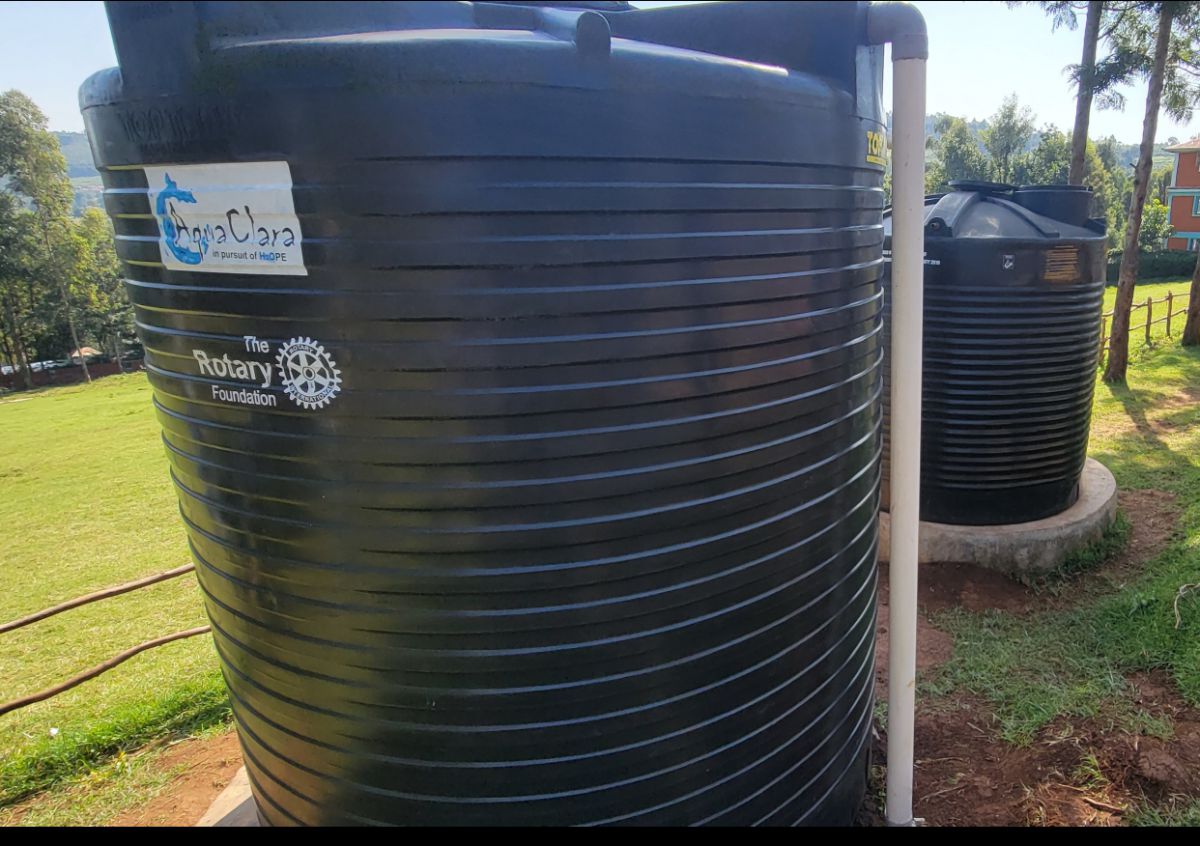 1,000 students
1,000 students -
HCF - a RURAL Health Care Facility
-
a single household with seven family members, chickens goats and one cow
-
a whole rural community in an LMIC with between 200 and 1,000 households.
Here are tailored checklists for each rainwater harvesting (RWH) scenario. Each checklist addresses technical needs, community involvement, behavior change, water safety, and long-term sustainability, with practical steps and examples for rural contexts in low- and middle-income countries (LMICs).
1. Rainwater Harvesting at a Rural School (200–1,000 students)
A. Planning & Community Engagement
-
Involve school staff, students, parents, and local leaders in discussions and decision-making[1].
-
Map out current water sources, needs (drinking, handwashing, toilets, cleaning), and student numbers.
-
Assign a school water committee, including teachers and older students.
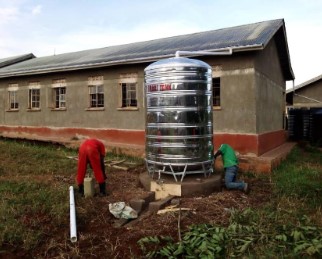
-
Calculate daily water needs (drinking, handwashing, toilets, cleaning).
-
Assess available roof area and rainfall patterns; ensure roof is clean and non-toxic.
-
Design gutters, downpipes, and first-flush diverters for large roof areas.
-
Size tanks to cover dry season and peak demand (e.g., exam periods).
-
Plan for multiple collection points (handwashing stations, drinking taps).
-
Use durable, food-safe materials and child-safe tank covers.
-
Build fencing to keep livestock and young children away from tanks.
-
Involve local artisans and train staff/students in basic maintenance.
-
Schedule regular cleaning of roofs, gutters, and tanks (at least once per term).
-
Train students and staff on safe water handling and hygiene.
-
Set up water quality testing (if possible) and disinfection routines.
-
Assign maintenance tasks to staff and older students (rotating schedule).
-
Keep a maintenance logbook.
-
Stock basic spare parts and cleaning supplies.
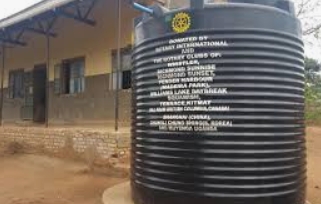
-
Integrate water, hygiene, and RWH topics into the curriculum.
-
Use posters, skits, and competitions to reinforce good practices.
-
Hold monthly committee meetings for feedback and problem-solving.
-
Plan for future increases in student numbers and water demand.
-
Celebrate water-saving achievements to keep motivation high.
A school in Fiji set up a “Water Club” where students led tank cleaning and hygiene campaigns, reducing absenteeism from waterborne disease[1].

2. Rainwater Harvesting at a Rural Health Care Facility (HCF)
A. Stakeholder Engagement
-
Involve health staff, facility managers, local government, and community reps.
-
Assess all water needs: drinking, cleaning, handwashing, sterilization, toilets, and patient care.

-
Calculate peak water demand (including emergencies).
-
Ensure roof is suitable, clean, and large enough.
-
Install robust gutters, first-flush diverters, and multiple tanks for redundancy.
-
Provide filtration and disinfection (chlorination, UV, or boiling as backup).
-
Ensure tanks and taps are accessible but secure from tampering or contamination.
-
Use high-quality, food-grade materials.
-
Protect tanks with fencing and signage.
-
Train staff in system operation and emergency repairs.
-
Set strict cleaning and disinfection schedules.
-
Test water regularly (especially after heavy rain or repairs).
-
Store water for emergencies (fire, outbreaks).
-
Assign clear responsibility for daily/weekly checks.
-
Keep detailed logs for cleaning, repairs, and water quality.
-
Stock spare parts and cleaning agents.
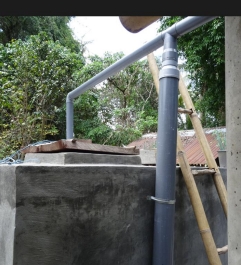
-
Train all staff on safe water use and reporting problems.
-
Post clear instructions at all water points.
-
Review system performance monthly.
-
Plan for scale-up as facility grows.
-
Link with local health authorities for ongoing support.
A rural clinic in Kenya reduced infection rates after installing RWH, with staff trained to disinfect tanks after every maintenance event[1][2].

3. Rainwater Harvesting for a Single Household
(7 people, chickens, goats, 1 cow)
A. Family Involvement
-
Include all family members (adults, youth) in planning and training.
-
Map water needs: drinking, cooking, washing, livestock.
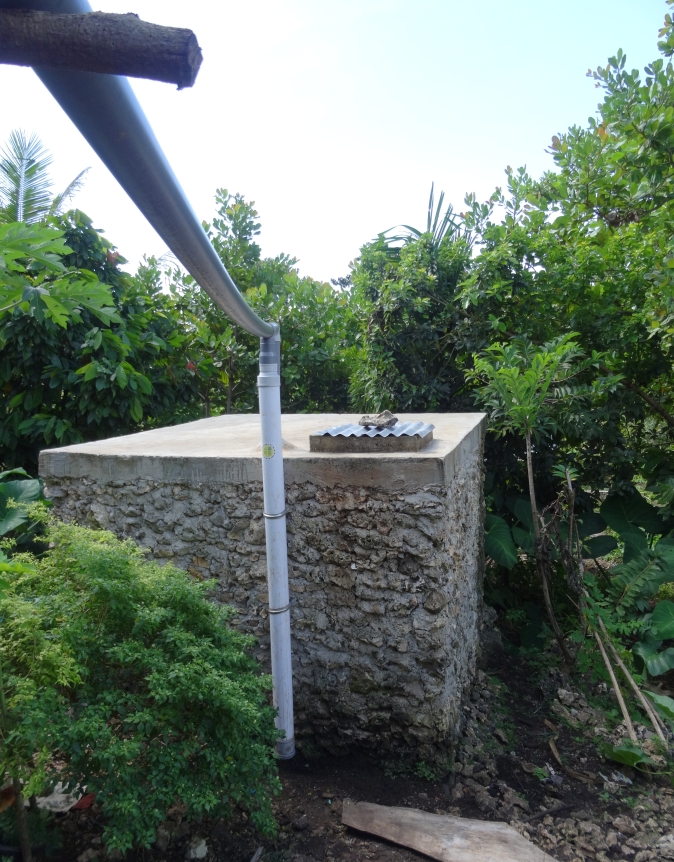
-
Calculate total water needs (including livestock).
-
Assess roof type and area; ensure it’s clean and suitable.
-
Install gutters, first-flush diverter, and a tank sized for dry season needs.
-
Use basic filtration (mesh, sand) and plan for regular disinfection.
-
Use affordable, locally available materials.
-
Protect tank from animals and small children (fencing or covers).
-
Clean roof, gutters, and tank regularly (at least once a year).
-
Disinfect tank after contamination or repairs (use household bleach as per guidelines)[1].
-
Store water in clean, covered containers.
-
Assign cleaning and repair roles within the family.
-
Keep a simple calendar for maintenance and cleaning.
-
Save for spare parts and repairs (e.g., a “water jar” for coins).
-
Teach all family members about safe water handling and hygiene.
-
Encourage reporting of leaks or problems immediately.
-
Review water use and tank levels, especially in dry season.
-
Adjust habits as family or livestock numbers grow.
A Nigerian family with goats and chickens used a 16,000-liter tank, cleaned annually, and rotated cleaning duties among older children and adults.

4. Rainwater Harvesting for a Whole Rural Community
(200–1,000 households)
A. Community Mobilization
-
Hold inclusive meetings (women, men, youth, elders, vulnerable groups).
-
Map all water sources, needs, and household locations.
-
Form a water committee with clear roles and gender balance.

-
Assess total water demand and available roof areas.
-
Plan for distributed systems (household tanks, communal tanks, or both).
-
Standardize system components for easier maintenance.
-
Design for future growth and climate variability.
-
Use local labor and materials where possible.
-
Train multiple community members in system construction and repair.
-
Protect all tanks and collection points from animals and children.
-
Organize regular community tank cleaning days.
-
Set up water quality monitoring (committee or trained volunteers).
-
Promote safe water handling at all distribution points.
-
Develop a community-wide maintenance plan and schedule.
-
Establish a fund for spare parts and major repairs (e.g., small monthly contributions).
-
Keep records of all maintenance, repairs, and water quality checks.
-
Run ongoing education campaigns (posters, radio, drama).
-
Involve schools and youth in water safety promotion.
-
Celebrate successes (e.g., “Clean Water Day” events).
-
Hold regular committee meetings and community feedback sessions.
-
Collect data on system usage, health impacts, and challenges.
-
Adjust plans as the community grows or faces new challenges.
-
Link with local government and NGOs for technical and financial support.
A Pacific Island community formed a water committee, organized annual “tank cleaning festivals,” and reduced waterborne illness by half within two years.
Final Note
For all scenarios, participatory approaches-where users help design, build, and maintain their systems-lead to better behavior change, ownership, and sustainability. Humor, local stories, and practical demonstrations help reinforce learning and make water safety everyone’s business.
“A clean tank is like a good friend: ignore it, and things get messy!”

References:
[1] Harvesting the Heavens: A Manual for Participatory Training in Rainwater Harvesting
[2] Rainwater Harvesting: A Lifeline for Human Well-being
WASH Rotary Action Group Annual Meeting
(Check your local time here https://www.timeanddate.
To participate in the Annual Meeting, you NEED TO REGISTER in advance by going to:
https://zoom.us/meeting/register/dZOKsKNpRLOIgmuBSzUg8A
Welcome and Opening Remarks - Pat Merryweather-Arges, Chair 2024-2025
Announcements
New Directors – Pat Merryweather-Arges
WASH Photography and Video Contest
WASH RAG Financial Status and DAF Funds - Michael Colasurdo, Treasurer WASH RAG
WASH Foundation Financial Status – Rod Kreie, Chair WASH Foundation
OPS Team Committees and Chairs; Grant process for Global WASH Grants and WASH Technical Grants
– Wade Nomura, Chair of WASH RAG Operations Team
– Stew Martin, Cadre Technical Officer
– Steve Werner and Carolyn Meub, Ambassador Program
WASH Board Officers for 2025-2026; Strategic Initiatives in 2025-2026
– Brian Hall, WASH Chair 2025-2026
Concluding Remarks and Gratitude – Pat Merryweather-Arges
Rainwater Harvesting 101
By Stew Martin, WaSH Cadre & WASH-RAG Technical Officer

In my 17 years of doing WASH projects, I've learned a lot about many things. When it comes to water supply, I find many Rotarians forget to consider rainwater.
Rain can be a great source of water - the sole source, or a supplemental source - in many regions of the world. Investigating climate, rainfall, uses in the community you serve and what others have tried (and failed or succeeded) can be very beneficial. It can save Rotary lots of money, time and trouble; and also provide more sustainability and climate resilience.
Of course, you'll have to overcome a few myths, like rainwater is free. While rain is free failing in the sky, it is not free when infrastructure is installed, water been collected, treated and made safe for human consumption. Depending on the area and nearby industry, rainwater can have a variety of contaminants - from pollutants, acidity, bacteria from bird poop - but often it is easy to treat. And most households can afford to pay modest fees for water that is safe, plentiful and nearby.
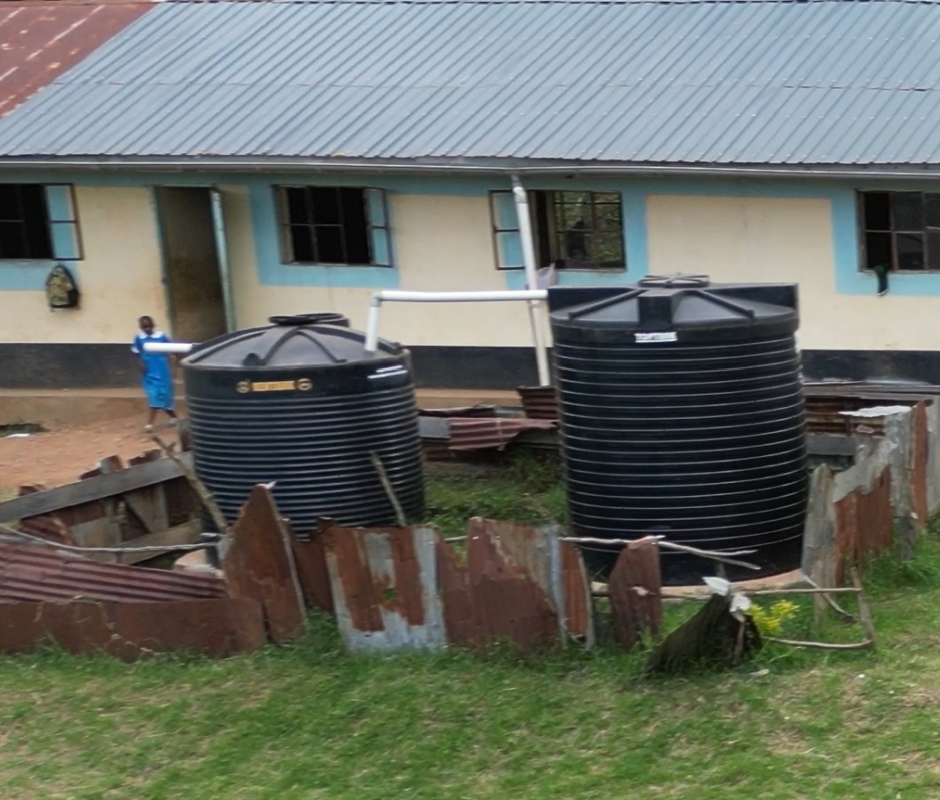
You'll want to think about the distribution of community buildings and houses, so people can have nearby access. Or whether it should feed into a central source of supply. This helps determine whether there will be large single collectors, distributed collectors, or small tanks serving household clusters. It's often too expensive to have each household collect, treat and manage its own rainwater – plus there will be the vagaries of people not following proper maintenance and sanitary procedures. (In a current joint Rotary & Engineers Without Borders project in Rwanda, Rainwater Harvesting (RWH) was seriously considered, but not at the household level.)
In the articles in this newsletter, we will explore many aspects of RWH as applied to rural, low and middle income countries (LMICs). There will be insights, technical details, how to treat rainwater, and a WASH-RAG Summit presentation.
Here’s a new feature - listen to the podcast, a lively “deep dive” into RWH in Hawaii, pastoralist East Africa, addressing constructing a system, treating contaminants and potential illness that come with some rain, socio-economics, and much more.
Enjoy droplets from the sky!
Key Aspects, Insights, and Know How
Introduction to Multiple Uses of Water (MUS) in Rural LMICs
For newcomers, understanding the Multiple Uses of Water (MUS) approach is crucial for improving water management in rural Low- and Middle-Income Countries (LMICs). This approach integrates domestic and livelihood needs, ensuring efficient water use. Here's a summary of key aspects, insights, and know-how for implementing MUS in such settings:
management in rural Low- and Middle-Income Countries (LMICs). This approach integrates domestic and livelihood needs, ensuring efficient water use. Here's a summary of key aspects, insights, and know-how for implementing MUS in such settings:
Key Aspects of MUS
- Integrated Water Use: MUS combines drinking water, small-scale irrigation, and livestock watering to enhance livelihoods and food security.
- Sustainability: Ensures groundwater sustainability and maintains water quality for drinking purposes.
- Cost Recovery: Encourages payment for water services to support maintenance and operation.
- Multi-Stakeholder Collaboration: Involves various government departments and international organizations to implement and manage MUS systems.
Insights from Madagascar

-
Climate Resilience: MUS helps communities adapt to climate change by providing consistent access to water for multiple uses.
-
Economic Benefits: Small-scale irrigation systems have increased income for poor families, particularly women, through vegetable cultivation.
-
Community Engagement: Involves community members in system management and maintenance, ensuring sustainability.
-
Technology Selection: Use appropriate technologies like handpumps, solar pumps, and micro-irrigation systems based on local conditions.
-
Community Mobilization: Educate communities on MUS benefits and involve them in decision-making processes.
-
Management Structure: Establish user groups and committees for managing water points and irrigation systems.
-
Financial Sustainability: Implement payment systems for water use to ensure ongoing maintenance and operation.
Technology Selection for Rainwater Harvesting and Multiple Uses of Water in Rural LMICs
.jpg)
When selecting technologies for rainwater harvesting and multiple uses of water in rural Low- and Middle-Income Countries (LMICs), several factors must be considered to ensure sustainability and effectiveness. Here are some key considerations and technologies:
Key Considerations
-
Local Context: Technologies should be appropriate for the local climate, geography, and community needs.
-
Cost and Maintenance: Systems should be affordable and easy to maintain with local resources.
-
Water Quality: Technologies should ensure water quality is preserved for drinking purposes.
-
Community Engagement: Involvement of the community in decision-making and management is crucial.
-
Rooftop Collection Systems: These are common and effective for collecting rainwater from roofs, using gutters and downspouts to channel water into storage tanks.
-
Rain Barrels or Cisterns: Equipped with filters, these are used in residential and commercial settings to store rainwater.
-
Rain Gardens: Landscaped areas that capture and filter rainwater, promoting groundwater recharge and reducing stormwater runoff.
-
Check Dams: Useful for soil and water conservation, flood mitigation, and groundwater recharge in arid regions.
-
Handpumps and Solar Pumps: Used for lifting water from boreholes for drinking, irrigation, and livestock.
-
Micro-Irrigation Systems: Efficient for small-scale agriculture, allowing for multiple crop cycles per year.
-
Concrete Water Troughs: Used for livestock watering, often located near boreholes.
-
Madagascar: Uses handpumps and solar pumps for MUS, combining drinking water supply with small-scale irrigation and livestock watering.
-
Kenya: Implements sub-surface dams and shallow wells for sustainable water management in pastoral areas.
-----------------------------------------
What are the best ways to assure RWH output is safe for humans?
Answer
Ensuring that rainwater harvesting (RWH) output is safe for human consumption involves several steps to minimize contamination and maintain water quality. Here are some of the best ways to assure RWH output is safe:
1. Proper Roof Selection and Maintenance
-
Roof Material: Use impermeable and non-toxic materials like galvanized iron, tiles, or metal sheets. Avoid organic materials like thatch or palm leaves as they can contaminate the water.
-
Roof Cleaning: Regularly clean the roof to remove debris, especially before the rainy season starts.
-
Gutter Design: Ensure gutters are properly sloped to prevent water from pooling and breeding mosquitoes.
-
Gutter Maintenance: Regularly clean gutters to remove debris and prevent contamination.
-
First-Flush Systems: Install devices that divert the initial flow of water from the roof, which often carries the most contaminants, away from the storage tank.
-
Inlet Filters: Use coarse and fine filters at the tank inlet to remove debris and contaminants.
-
Outlet Screens: Ensure all outlets are screened to prevent re-contamination.
-
Tank Material: Use durable, non-toxic materials for the tank.
-
Tank Covering: Keep the tank covered to prevent light entry, which can promote algae growth and contamination.
-
Regular Cleaning: Periodically inspect and clean the tank to remove sediment and prevent bacterial growth.
-
Disinfection Methods: Consider additional treatment methods like boiling, solar disinfection (SODIS), or UV treatment for drinking water.
-
Water Quality Monitoring: Regularly test the water for bacterial, chemical, and physical contaminants to ensure it meets safety standards.
Podcasts to Prose
 Organizations, including Rotary, still use a lot of printed materials. Videos are being used more and are a great way to get across information.
Organizations, including Rotary, still use a lot of printed materials. Videos are being used more and are a great way to get across information.One medium source that has become popular is Podcasts. Listen to this 24-minute podcast that explains Rainwater Harvesting. Click Here.
At World Water Summit 16, Stew Martin provided a great introduction to Rainwater Harvesting. You can view his PowerPoint presentation. Click Here.
To read the Prose recited by Stew, use the Read More link.
Buckets, Barrels, and Big Ideas: A Rotary Tale of Rainwater Revival
It starts with a single drop.
That tiny, shimmering bead falling from the heavens holds a secret. It's not just water—it's dignity, it's health, it's time returned to a mother who once walked for hours each day with a heavy jerrycan bouncing against her hip. It’s the laughter of children who can stay in school instead of trekking dusty paths to fetch murky water. And yes, it's even better tea, because rainwater, filtered just right, brews with the flavor of hope.
Welcome to the world of Rotary WaSH, where we take our water—and community dreams—seriously. Armed with spreadsheets, solar pumps, and a global fellowship of do-gooders, we venture into communities with an open ear, clipboards and commitment.
And among the many acronyms and noble engineering feats in WaSH (Water, Sanitation and Hygiene), there sits an elegant, ancient, and profoundly empowering idea: Rainwater Harvesting.
We like to call it “catching the sky before it hits the ground.”
You see, rain doesn’t discriminate. It falls on zinc roofs and banana leaves alike, over temples and goat sheds, mosques and mango trees. It taps out rhythms on tin roofs in Rwanda and dances down the gutters of Guatemalan schools. The trick—no, the art—is to catch it, clean it, and share it.
And that’s where Rotarians shine.
In our stylish blue & gold vests (or local straw sun hats), we gather in villages and city slums, armed with the Rotary Four-Way Test and enough enthusiasm to irrigate a desert. We assess & measure roofs. We hike hills to review reservoirs. We debate gutter angles like philosophers in a Greek agora. We talk tank sizes like sommeliers discuss vintage wines—“Ah yes, a fine 50,000-liter ISSB pairs wonderfully with 28 households each with three chickens a goat, and a longer dry season.”
We do it for the farmer whose crops thirst by April. For the nurse in the health clinic who scrubs her hands with hope and bottled water. For the grandmother who prays for rain and now stores it with pride.
And while the technology may be humble—gutters, tanks, filters, and a first flush that sounds more like plumbing prose than public health—we know that what we’re building isn’t just infrastructure. We’re building resilience.
We are making space—for children to learn, for mothers to rest, for families to grow food, raise goats, and laugh together—without worrying on hidden illness in their next drink of water.
Rotary's genius isn’t just in fundraising or fitting tanks to stable platforms (though we’re getting better at those too). It’s in weaving together engineers and dreamers, local wisdom and global grit, to create something as quietly revolutionary as a full rain barrel with soap beside a clean latrine.
Yes, it takes planning. It takes cultural humility, and a willingness to learn what the community already knows (spoiler: that is a lot!). We take the time to go the extra mile – measure, learn, and improve our methods. It also takes a sense of humor. Because if you can’t laugh when a goat climbs into your trench mid-site visit, or when your demo filter bursts like a geyser during your “success speech,” then are you even doing Rotary right?
So here’s to the Rotarian with muddy boots, to the Ambassador sketching tank diagrams on napkins, to the grandmother who names her rain tank “Blessing.” Here's to a world where clean roofs are harvesters, not just shelters.
Because in the end, every drop we catch is a promise kept.
And every tank we build is a step toward a future where clean water flows—and hope overflows.
Rotary: We don’t just change lives.
We catch the rain that changes everything.
Scope, Size, and Sustainability
By Stew Martin, WaSH Cadre & WASH-RAG Technical Officer
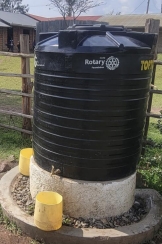
In deciding whether and how to collect rainwater, the most important aspects to consider are the local context: climate and how it is changing, water uses, the spread of the community. Remember likely increased future water demand once people have plentiful safe water. What methods of construction does the community currently use - bamboo and machete? Rock or stone with cement mortar? Could they acquire and use interlocking stabilized soil blocks (ISSB)? Are local contractors already good making ferrocement tanks with rebar and cement? What materials and tools are in local hardware stores or shops?
Investigate other water sources that exist now and noodle over whether RWH will be a supplement or a main source. Examine at the pattern of homes and public buildings in the community where people comfortably walk and how far things are away (local eyes plus Google Earth can help).
Consider the slopes and whether a gravity-fed system is possible, or if there is an electric grid or solar mini
 grid to power pumps. Use a water engineer (with hydraulics skills) to consider where tanks should be located for maximum advantage,and what pipe runs, relief and valving is needed. Don’t forget meters, to track leaks and usage. The engineer can give rough estimates for construction that will start to shape the budget.
grid to power pumps. Use a water engineer (with hydraulics skills) to consider where tanks should be located for maximum advantage,and what pipe runs, relief and valving is needed. Don’t forget meters, to track leaks and usage. The engineer can give rough estimates for construction that will start to shape the budget.Be careful to draw your line around the community that “acts like a community” - not just in name, but footpaths and roads, market & economic connections, social connection, and other practical aspects.
Consider whether Rotary collaborating with local government, vendors and distributors can build demand, can train artisans and provide a supply chain of tools and materials - so RWH becomes a local enterprise, not just a parachuted project that may not last.
Assemble the names and meet with local NGOs, regional or international NGOs working in the area - include local government (water & community developments), any government technical working groups - discuss with them the ideas of your project and get candid feedback.
In the end, you and the community together will decide whether this works, at what scale and what methods. Will it be a large metal roofs with ISSB tanks, or ferrocement tanks set in the soil of a hillside, or household cluster tanks hand-built from stone, or plastic UV-rated tanks. Consider longer-lasting roof materials like aluminized corrugated steel, PVC, plastic gutters and hardware - if they are available in the rural setting - and if contractors know how to install, and the community will really maintain them. Worst case (not up to Rotary standards) they may choose to use machetes, filter screens and cloth or household biosand filters; but at least they will have more water.
Lastly, consider the education of households and whether they are curious and willing to learn then change their behavior to reduce deforestation, reduce boiling, and make water safe to use. Try a pilot test (direct club donation), verify the approach is sound, then maybe a small grant ... before diving into a big global grant. Some day you can advocate and assemble a group for a larger scale regional water project … but probably not to start.
FAQ on Rainwater Harvesting
by Stew Martin with help from AI software Perplexity

This Frequently Asked Questions (FAQ) provides a comprehensive overview of Rainwater Harvesting (RWH), including its basics, implementation, and how to promote it as a Rotary global grant project. It’s designed to inspire Rotarians and Rotaractors to take action and collaborate for impactful humanitarian projects.
What is Rainwater Harvesting (RWH)?
Rainwater Harvesting is the collection, storage, and use of rainwater for various purposes such as drinking, irrigation, sanitation, and groundwater recharge. It’s a sustainable solution to water scarcity and can be adapted for both rural and urban settings.
Key Components of a Rainwater Harvesting (RWH) System:
-
Catchment Area: Roofs or other surfaces where rainwater is collected.
-
Conveyance System: Gutters and pipes that channel rainwater to storage.
-
Storage: Tanks, ponds, or cisterns where water is stored for later use.
-
Treatment: Filtration or disinfection systems to ensure water quality for drinking.
-
Addresses Water Scarcity: Provides a reliable water source in areas with seasonal rainfall or limited access to clean water.
-
Improves Livelihoods: Supports agriculture, reduces time spent fetching water, and improves health outcomes.
-
Environmentally Friendly: Reduces pressure on groundwater and surface water resources while mitigating flooding and soil erosion.
-
Cost-Effective: Uses local materials and simple technology, making it affordable and sustainable.
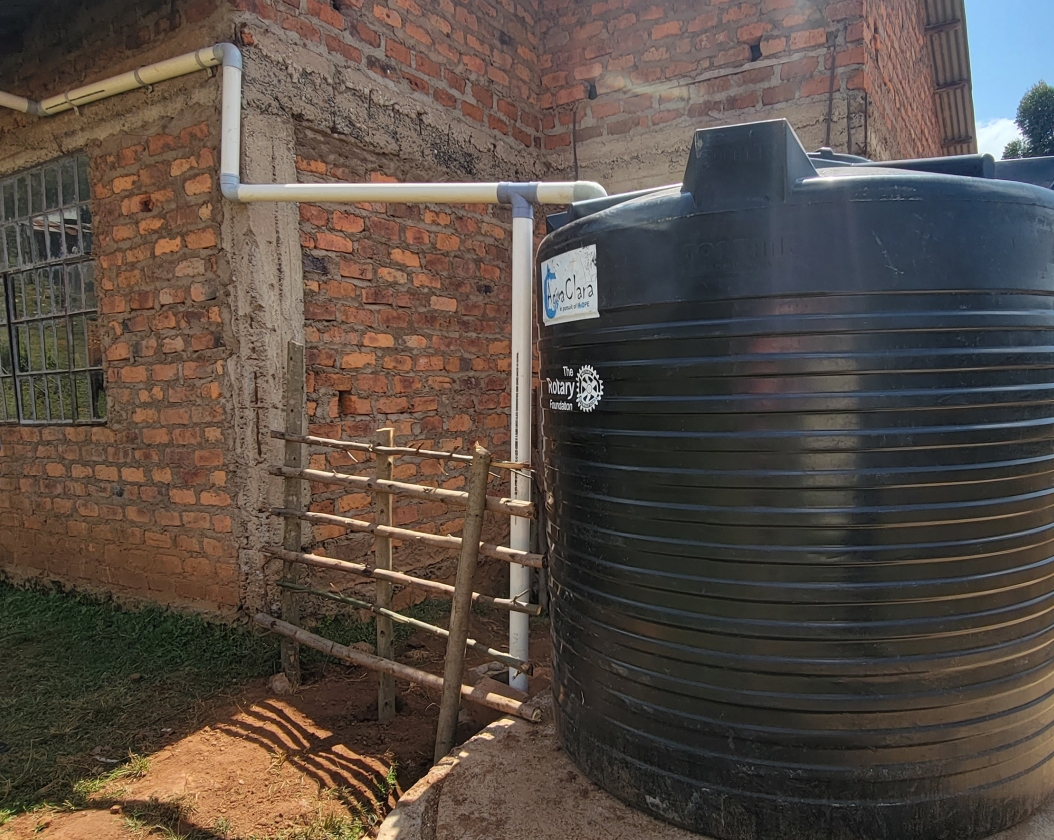
-
Assess Community Needs:
-
Conduct surveys to understand water challenges and priorities.
-
Identify suitable locations for catchments and storage.
-
-
Design the System:
-
Choose appropriate technologies based on local conditions (e.g., rooftop systems for homes or ponds for agriculture).
-
Ensure compliance with national WaSH (Water, Sanitation, Hygiene) standards.
-
-
Engage the Community:
-
Form a Water Management Committee to oversee the project.
-
Train local artisans in construction and maintenance to build local capacity.
-
-
Construct the System:
-
Use locally available materials like ferro-cement tanks or PVC pipes.
-
Install first-flush diverters and filters to maintain water quality.
-
-
Monitor & Maintain:
-
Regularly inspect gutters, tanks, and filters.
-
Test water quality periodically to ensure safety.
-
-
Highlight Its Impact:
-
Emphasize how RWH aligns with Rotary’s focus areas like clean water, sanitation, economic development, and environmental sustainability.
-
Share success stories from similar projects in other regions.
-
-
Engage Your Club:
-
Present RWH at club meetings with visuals of successful implementations.
-
Organize site visits to communities benefiting from RWH systems.
-
-
Collaborate with Other Clubs:
.jpg)
-
Invite clubs in your district or internationally to co-sponsor the project.
-
Share responsibilities like fundraising, technical support, or monitoring.
-
-
Leverage Partnerships:
-
Work with local governments for approvals and technical expertise.
-
Partner with NGOs or experts in water management for guidance.
-
-
Apply for a Rotary Global Grant:
-
Develop a detailed project proposal with clear objectives, budgets, and sustainability plans.
-
Highlight community involvement as a key component of the project’s long-term success.
-
-
Health Benefits:
-
Reduces waterborne diseases by providing clean drinking water.
-
-
Education:
-
Frees up time for children (especially girls) who would otherwise fetch water, improving school attendance.
-
-
Economic Growth:
-
Enables small-scale irrigation for farming, increasing food security and income.
-
-
Environmental Sustainability:
-
Recharges groundwater and reduces soil erosion.
-

-
Visit resources like UNEP’s Rainwater Harvesting: A Lifeline for Human Well-Being report or WASH-RAG (Water Sanitation Hygiene Rotarian Action Group).
-
Attend Rotary webinars or workshops on WaSH projects.
-
Connect with experienced Rotarians who have led successful RWH initiatives.
-
Send personalized invitations explaining the project’s goals and potential impact.
-
Host an informational session highlighting how clubs can contribute (e.g., funding, expertise).
-
Create a shared platform (e.g., WhatsApp group) for collaboration and updates.
Taking the AI Rainwater Elevator
By providing the AI software (Perplexity) the following Question:

Imagine a brief conversation between a WASH-RAG ambassador (promoting and explaining importance) and a lay Rotarian who "wants to do good in the world". Write a 30 second elevator speech that is catchy, inviting, has a bit of humor - and will excite the Rotarian to learn more then do a RWH project.
You get the following Answer:
Here's a catchy, inviting, and humorous 30-second elevator speech from a WASH-RAG ambassador to a fellow Rotarian interested in "doing good in the world":
"Hey there! Did you know there's gold falling from the sky—well, liquid gold anyway? I'm talking about rainwater harvesting—catching raindrops to change lives. Imagine giving families clean water at their doorstep, kids spending more time in school instead of fetching water, and communities growing veggies year-round. Rotary clubs around the world are tapping into this ancient yet genius solution—simple roofs, local materials, big smiles. Even local governments love it! Want to help turn raindrops into hope? Let's chat more about how your club can make a splash!"
If you revised the AI question:
Revised instruction: Okay, that's pretty corny ... remember Rotarians are usually business and professional people; and Rotaractors are young professional adults. Redo it and make it audience-appropriate.
Got it! Here's a more polished and professional version, tailored for Rotarians and Rotaractors:

"Clean water changes everything—health, education, livelihoods—and rainwater harvesting is one of the smartest ways to make that happen. It’s cost-effective, sustainable, and empowers communities to take charge of their water needs. Imagine a rural village where families no longer have to walk miles for water, schools have reliable supplies, and local economies thrive because of better access. As Rotarians, we’re all about sustainable impact—and this is a project that delivers. Interested in turning rain into results? Let’s discuss how your club can lead the way."
You can further refine the Instruction: Much better, thanks. Now give me a 90-second version, same voice and situation.
The AI software provides the Answer:
Here’s a 90-second version, keeping it professional and engaging:
"Water is life, right? But for millions of people, access to clean water is still a daily struggle. That’s where rainwater harvesting comes in—a simple, sustainable solution that can transform entire communities. Think about it: instead of walking miles to fetch water, families can collect clean rainwater right at their homes. Schools get reliable water for drinking and handwashing, improving attendance and health. Farmers can irrigate small gardens, boosting nutrition and incomes. It’s not just about water—it’s about dignity, opportunity, and resilience.
As Rotarians, we focus on long-term impact, and rainwater harvesting ticks every box: it’s scalable, cost-effective, and empowers communities to take ownership. Plus, it aligns perfectly with Rotary’s focus areas like water and sanitation, education, and economic development. And here’s the best part—it’s a project your club can lead with local partnerships, using accessible materials and technology.
So, whether you’re looking to make a difference in one village or scale up across a region, rainwater harvesting is a smart investment with lasting results. Ready to dive in? Let’s talk about how your club can turn this vision into action."
Sample RWH system in Rural Nigeria

Design a RWH system in a rural community in Nigeria with moderate rainfall. Use community empowerment, local methods and materials, make it sustainable long-term, demonstrate that it is a Rotary project, involve the local government to approve, supervise and provide tech support - and provide long-term sustainable impact on the needs of households. The community has 200 houses, a primary school, a mosque and a small community center. It is about 2 miles across, slightly hilly. Meet national and international WaSH standards.
It provided the following:
Project Overview
Location & Community: A rural Nigerian community, moderately rainy climate, slightly hilly terrain, about 2 miles across. The village has around 200 households, a primary school, a mosque, and a community center.
Objectives:
-
 Provide safe drinking water and water for domestic use.
Provide safe drinking water and water for domestic use. -
Empower the community through involvement in planning, installation, management, and maintenance.
-
Ensure long-term sustainability and compliance with national/international WaSH (Water, Sanitation & Hygiene) standards.
-
Demonstrate Rotary Club involvement clearly.
Community Empowerment:
-
Community-led planning workshops: Engage residents early to identify their priorities and preferences. Clearly explain RWH benefits and responsibilities.
-
Rotary branding: Clearly mark all tanks and public facilities with Rotary International logos/signage to demonstrate sponsorship and partnership.
-
Form a local Water Management Committee (WMC), including representatives from households, school, mosque, community center, Rotary Club members, and local government officials.
-
Obtain official approval from the Local Government Area (LGA).
-
Partner with LGA WaSH officers for supervision during construction.
-
Request technical support from government engineers for training in construction techniques and regular water quality testing.

Technical Design:
.jpg)
The community has approximately 200 houses spread over 2 miles of slightly hilly terrain. It also includes one primary school, one mosque, and one community center.
System Components:
1. Catchment Areas
-
Utilize rooftops of houses (galvanized iron or aluminum sheets), primary school building, mosque roof, and community center roof as catchment surfaces.
-
Encourage regular cleaning of roofs before rainy seasons to minimize contamination.
-
Install locally-made gutters (PVC or metal) along roof edges to channel rainwater into storage tanks.
-
Include mesh screens at gutter entry points to prevent debris entry.
-
Install simple first-flush diverters made from locally available PVC pipes to discard initial runoff containing contaminants.
-
Construct ferro-cement tanks using locally available materials (cement, sand, gravel) reinforced with chicken wire or mesh. These are cost-effective and durable.
-
Place tanks strategically across the community—group clusters of 10 houses share one large tank (~20 tanks total), plus separate larger tanks for the school, mosque, and community center.
-
Size tanks based on rainfall data analysis from similar Nigerian communities (e.g., Edo state studies suggest rooftop areas around 6,000 m² can easily meet annual demand.
-
Tanks should be covered to prevent algae growth and mosquito breeding.
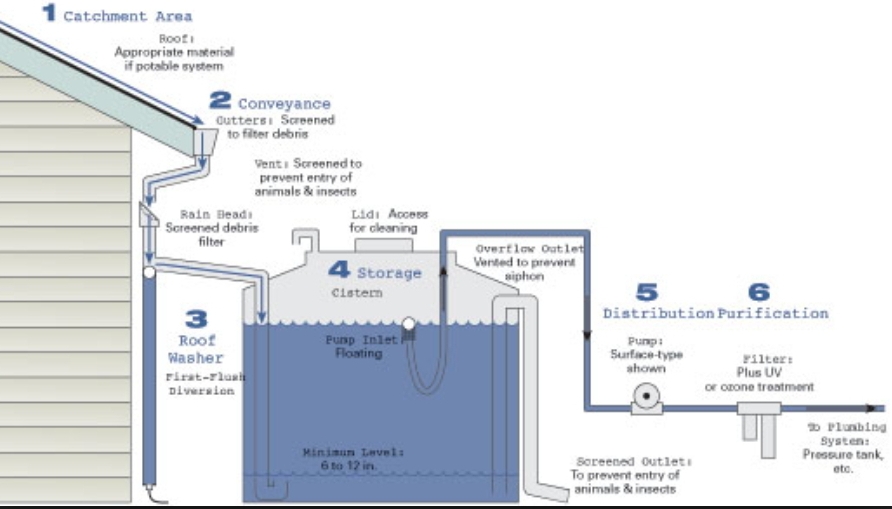
-
Install simple first-flush diverters (PVC pipes) on each tank inlet to discard initial contaminated runoff.
-
Use low-cost filtration methods such as sand filters or cloth filters at tank inlets to remove debris.
-
Regularly test water quality following WHO/Nigerian standards for drinking water—checking turbidity, pH levels, fecal coliform bacteria counts.
-
Promote household-level treatment methods like boiling or solar disinfection (SODIS) using clear plastic bottles exposed to sunlight for drinking water.
-
Provide simple taps at each tank for easy access by households.
-
For school/mosque/community center tanks: install multiple taps at child-friendly heights to encourage handwashing practices.

Community Empowerment & Capacity Building:
-
Conduct training workshops on system installation techniques (ferro-cement tank construction), operation/maintenance procedures (cleaning gutters/tanks), hygiene education (handwashing practices), and basic water testing methods.
-
Train local artisans/builders on ferro-cement tank construction as an income-generating skill.
-
Engage women actively in decision-making processes—women often manage household water use and hygiene practices.

Rotary Club Visibility & Branding:

-
Clearly label all tanks/facilities with Rotary International logos/signage acknowledging partnership with local government agencies.
-
Organize inauguration ceremonies involving Rotary representatives and local government officials to reinforce visibility and commitmen

-
Establish a small monthly fee from households to cover maintenance costs managed by the WMC; fees waived or reduced for vulnerable families through collective agreement.
-
Create a local fund managed by WMC for repairs/replacement parts ensuring financial sustainability without external dependency long-term.
-
Train local technicians through collaboration with LGA WaSH officers for ongoing technical support.
-
Encourage periodic monitoring visits by LGA officials to ensure compliance with national/international WaSH standards.

Expected Benefits:
-
Improved Health: Reduced incidence of waterborne diseases due to safe drinking water availability.
-
Livelihood Enhancement: Time saved fetching water can be redirected toward education or productive activities; increased resilience during dry periods.
-
Environmental Sustainability: Reduced pressure on groundwater sources; improved groundwater recharge through controlled runoff management.
But don't assume these ... set up a reliable monitoring system, to gather credible data - see if it is happening. If not, adjust the project methods until you can verify the outcome.
Is Rainwater Safe?

Ensuring that rainwater harvesting (RWH) output is safe for human consumption involves several steps to minimize contamination and maintain water quality. Here are some of the best ways toassure RWH output is safe:
1. Proper Roof Selection and Maintenance
-
Roof Material: Use impermeable and non-toxic materials like galvanized iron, tiles, or metal sheets. Avoid organic materials like thatch or palm leaves as they can contaminate the water.
-
Roof Cleaning: Regularly clean the roof to remove debris, especially before the rainy season starts.
-
Gutter Design: Ensure gutters are properly sloped to prevent water from pooling and breeding mosquitoes.
-
Gutter Maintenance: Regularly clean gutters to remove debris and prevent contamination.
.jpg)
-
First-Flush Systems: Install devices that divert the initial flow of water from the roof, which often carries the most contaminants, away from the storage tank.
-
Inlet Filters: Use coarse and fine filters at the tank inlet to remove debris and contaminants.
-
Outlet Screens: Ensure all outlets are screened to prevent re-contamination.
-
Tank Material: Use durable, non-toxic materials for the tank.
-
Tank Covering: Keep the tank covered to prevent light entry, which can promote algae growth and contamination.
-
Regular Cleaning: Periodically inspect and clean the tank to remove sediment and prevent bacterial growth.
-
Disinfection Methods: Consider additional treatment methods like boiling, solar disinfection (SODIS), or UV treatment for drinking water.
-
Water Quality Monitoring: Regularly test the water for bacterial, chemical, and physical contaminants to ensure it meets safety standards.

Handling Rainwater Contaminents
by Stew Martin and Perplexity “Deep Research”
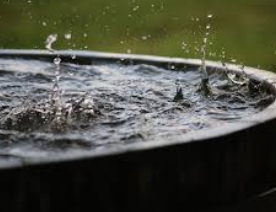 (NOTE: See some personal tips from Stew at the bottom)
(NOTE: See some personal tips from Stew at the bottom)Prompt: Some people believe that rain water is pure and has no contaminants. is this true? When it falls from the sky does it collect pollutants, acids or chemicals? When it lands on metal roofs in LMIC rural villages, what debris or contaminants are added to the rainwater? If it should be treated, what is the best way to treat or filter the water to make it potable for human consumption? Keep in mind that households income and budgets are very small.
Rainwater is often perceived as pure, but this is a misconception. While it starts relatively clean, it collects contaminants as it falls through the atmosphere and lands on surfaces. Here’s a breakdown of the risks and practical solutions, tailored for low-income households:
Is rainwater pure when it falls?

No. Rainwater absorbs pollutants like PFAS (toxic "forever chemicals" from plastics)
1, acidic compounds (from volcanic emissions or fossil fuels)
2, and airborne particulates (dust, pesticides, industrial emissions)
3. Even in remote areas, studies show rainwater now exceeds safe chemical thresholds for drinking.
Contaminants added by metal roofs in rural LMIC villages:
-
Debris: Leaves, bird/rodent droppings, and insects.
-
Metals: Rust, zinc, or lead (from older painted roofs).
-
Chemicals: Residues from roofing materials or nearby agricultural pesticides.
-
Microbes: Bacteria (e.g., E. coli), viruses, and parasites from animal waste.
-
First-flush diversion:
-
Install a simple device to discard the initial rainwater (which carries most roof debris). A $5–10 homemade system using PVC pipes can divert contaminated water.
-
-
Basic filtration:
-
Cloth/sand filters: Layer clean cloth, gravel, and sand in a bucket to remove particles.
-
Charcoal filters: Crushed charcoal in a container helps absorb chemicals.
-
-
Disinfection:
-
Chlorination: Add 2–4 drops of unscented bleach per liter (6% sodium hypochlorite). Let sit for 30 minutes.
-
Solar disinfection (SODIS): Fill clear plastic bottles, expose to sunlight for 6+ hours (UV rays kill pathogens).
-
Boiling: Heat water to a rolling boil for 1 minute (effective but fuel-intensive).
-
-
Safe storage:
-
Use covered, food-grade containers to prevent recontamination. Clean tanks annually to remove sludge.
-
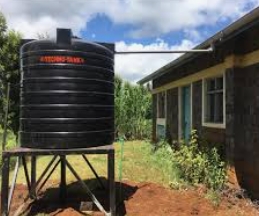
-
Cost: Prioritize locally available materials (e.g., reused bottles for SODIS, sand/gravel for filters).
-
Behavior change: Educate communities on regular gutter cleaning and tank maintenance.
-
Sustainability: Pair rainwater harvesting with drought-resistant crops to maximize water use efficiency.
Prompt: What are the most effective low-cost methods to filter rainwater for drinking
Answer:
Rainwater can be a vital water source, but effective low-cost filtration is essential for safety. Here are proven methods tailored for households with limited budgets:
1. First-Flush Diversion
Discard the initial rainwater (which carries roof debris, bird droppings, and pollutants) using a simple PVC pipe system. A $5–10 homemade device can divert the first 2–5 mm of rainfall13. This reduces up to 90% of contaminants before storage.
2. Basic Filtration
-
Cloth or Mesh Filters: Use clean cotton cloth or fine mesh to remove large debris. Ideal as a first step.
-
Sand and Gravel Filters: Layer coarse sand, fine sand, and gravel in a bucket. Removes particles and some microbes.
-
Charcoal Filters: Crushed charcoal (from burnt wood) in a cloth bag absorbs chemicals and improves taste.
-
Solar Disinfection (SODIS): Fill clear PET bottles with filtered water, expose to sunlight for 6+ hours. UV rays kill pathogens like E. coli13. Cost: $0 (uses recycled bottles).
-
Chlorination: Add 2–4 drops of unscented bleach (6% sodium hypochlorite) per liter. Wait 30 minutes before drinking13. A bottle of bleach costs ~$1–2 and lasts months.
-
Boiling: Bring water to a rolling boil for 1 minute. Effective but fuel-intensive.
Use covered, food-grade containers (e.g., cleaned jerrycans) to prevent recontamination. Clean tanks annually to remove sludge.
Cost-Effective Combinations
-
First-flush + cloth/sand filter + SODIS: Under $10 for materials, addresses particles and microbes.
-
Charcoal filter + chlorination: Removes chemicals and pathogens for ~$5 upfront.
-
Roof and Gutter Maintenance: Clean roofs/gutters regularly to reduce contaminants.
-
Local Materials: Use PVC pipes, recycled bottles, or bamboo for systems.
-
Community Training: Education on filter upkeep and hygiene ensures long-term success.
Prompt: What about fiber ultra filtration like Sawyer and Lifestraw? Are there any high-quality ultrafiltration or nanofiltration filters available in the supply chain of LMIC countries? Which are relatively available, and at what prices?
Answer:
Ultrafiltration (UF) and nanofiltration (NF) filters like Sawyer and LifeStraw are increasingly available in LMIC supply chains, though accessibility and pricing vary. Here's a breakdown:
1. Available UF/NF Filters in LMICs
.jpg)
-
Sawyer PointOne ($20–$50):
-
Widely distributed by NGOs (e.g., MSF, Red Cross) in sub-Saharan Africa and South Asia.
-
Sold in local markets in Kenya, Uganda, and Nepal, but prices can double due to import taxes.
-
-
LifeStraw Family ($25–$40):
-
Common in emergency responses (e.g., Ethiopia, Haiti). Local retailers in urban centers stock it at ~$30–$45.
-
-
Tata Swach (India, ~$15–$25):
-
Uses UF technology; subsidized via government programs.
-
-
Nazava (Indonesia, ~$10–$20):
-
Ceramic+UF hybrid; sold locally and online.
-
-
NGO/Government Programs: Filters like Sawyer are often free or subsidized during cholera outbreaks (e.g., DRC, Yemen).
-
Local Production:
-
India: Tata Swach and Swajal (solar-powered NF systems, ~$200–$500).
-
China: Qingdao ECOTECH exports UF systems to African markets (~$50–$100).
-
-
Urban vs. Rural: Urban pharmacies and hardware stores stock branded filters; rural areas rely on NGO distribution.
-
Retail Markup: Imported filters cost 2–3× more in LMIC markets (e.g., Sawyer Mini retails for ~$50 in rural Kenya).
-
Local Alternatives:
-
Ceramic filters (e.g., Potters for Peace, ~$10–$15) are cheaper but less effective against viruses.
-
Biosand filters ($5–$30) lack UF precision but are widely used.
-
-
Maintenance: UF filters require periodic backwashing; replacement membranes cost ~$5–$10 (often scarce in rural areas).
-
Effectiveness:
-
UF removes 99.9999% of bacteria/protozoa but not viruses (NF needed).
-
LifeStraw Community (UF) is popular in schools and clinics.
-
-
Solar-Distillation Stills (e.g., SunSpring, ~$1,500–$3,000): High-cost NF systems for institutions.
-
Hybrid Systems: Pairing UF with chlorine tablets (e.g., Aquatabs) for viral protection (~$0.01/tablet).
Prompt: You are not addressing the specific contaminants that come in rainwater, which you described about. Address those now and tell me which filters or treatment are most effective? Does chlorination remove all contaminants, if not, which one does it fail to remove? Does ultrafiltration remove all, if not, which ones does it fail to remove? What are the best solutions at each price point: under $20? Under $50? under $100? Under $200?
Answer:
Comprehensive Analysis of Rainwater Contaminants and Cost-Effective Treatment Solutions
Rainwater, while a vital resource in low- and middle-income countries (LMICs), carries significant contamination risks. This report synthesizes evidence from global studies to outline specific pollutants, evaluate treatment methods, and recommend solutions across budget tiers.
Key Contaminants in Rainwater
1. Chemical Pollutants

-
PFAS ("forever chemicals"): Found in rainwater globally at levels exceeding U.S. EPA guidelines, even in remote regions like Antarctica. These toxic compounds linked to cancer and immune dysfunction persist indefinitely in the environment.
-
Metals: Zinc, lead, and copper leach from galvanized or painted metal roofs. For example, zinc concentrations in industrial roof runoff can exceed aquatic toxicity limits by 20×4. Lead levels in rainwater from zinc roofs in Indonesia reached 222 µg/L-over 40× the WHO limit.
-
Hydrocarbons: Gasoline, diesel, and motor oil residues wash into rainwater from roads and parking lots.
-
Pathogenic bacteria: Mycobacterium tuberculosis (tuberculosis), Listeria monocytogenes, and Yersinia spp. detected in 92–100% of roof-harvested samples3.
-
Viruses and protozoa: Rotavirus and Cryptosporidium often survive basic filtration.
-
Microplastics and turbidity: Present in 90% of urban runoff samples, reducing water clarity and harboring pathogens.
Chlorination
-
Removes: Bacteria (e.g., E. coli), viruses, and protozoa when used correctly.
-
Fails to remove:
-
PFAS and hydrocarbons.
-
Metals (lead, zinc).
-
Particulates (requires pre-filtration).
-
-
Removes: 99.9999% of bacteria/protozoa, microplastics, and turbidity.
-
Fails to remove:
-
Dissolved chemicals (PFAS, pesticides).
-
Viruses (if pore size >0.01 µm).
-
Metals (unless bound to particles).
-
-
Removes: 90–98% of divalent metals (zinc, lead), 50–80% of monovalent ions (sodium), and some PFAS.
-
Limitations: High cost (~$200–$500 for household systems) and energy demands.
Under $20
-
First-flush diverter + cloth/sand filter
.jpg)
-
Discards initial contaminated runoff (reduces metals/debris by 90%).
-
Layered sand/gravel removes particulates; charcoal improves taste.
-
Cost: $5–$10 (PVC pipes, local sand).
-
-
Solar Disinfection (SODIS)
-
UV rays in clear PET bottles destroy bacteria/viruses after 6+ hours.
-
Cost: $0 (reused bottles).
-
-
Basic chlorination
-
2–4 drops of 6% bleach per liter neutralizes pathogens.
-
Cost: $1–$2 per month.
-
-
Ceramic filter + colloidal silver
-
Removes 99.9% of bacteria/protozoa; silver inactivates viruses.
-
Cost: $15–$25 (locally produced, e.g., Potters for Peace).
-
-
Sawyer Mini UF filter
-
0.1 µm pores eliminate bacteria/protozoa; lasts 1,000 gallons.
-
Cost: $20–$25 (NGO-subsidized in Kenya/Uganda).
-
-
Hybrid biosand filter
-
Sand/gravel layers + biofilm remove 70–90% of pathogens.
-
Cost: $25–$40 (local concrete and materials).
-
-
Tata Swach UF system
-
Indian-made filters combine UF with activated carbon for metals/chemicals.
-
Cost: $50–$80 (subsidized government models).
-
-
Charcoal-NF hybrid
-
Crushed charcoal (chemical adsorption) + nanofiltration membrane (metals).
-
Cost: $70–$90 (DIY systems using recycled components).
-
-
Community-scale UF + chlorination
-
Sawyer Squeeze ($50) paired with bulk chlorine tablets ($0.01/unit).
-
Services 10–20 households; reduces viral risks6.
-
-
Solar-powered NF system
-
Removes 95% of PFAS and metals; used in Kenyan schools.
-
Cost: $150–$200 (NGO-installed).
-
|
Contaminant
|
Best Treatment Combo
|
Cost Range
|
|
Bacteria/Protozoa
|
Ceramic filter + SODIS
|
$15–$30
|
|
Viruses
|
UF + chlorination
|
$40–$60
|
|
Metals (Pb, Zn)
|
First-flush + NF/charcoal hybrid
|
$70–$120
|
|
PFAS/Chemicals
|
Activated carbon + NF (if available)
|
$150–$200
|
|
Turbidity/Microplastics
|
Biosand + cloth pre-filter
|
$10–$25
|
Conclusion
No single method addresses all rainwater contaminants. LMIC households should prioritize:
-
First-flush diversion to reduce heavy metals and debris.
-
Multi-stage filtration (sand ? charcoal ? ceramic) for particulates and bacteria.
-
Hybrid disinfection (SODIS + chlorination) for viral threats.
Prompt: In Rwanda, which of the above filters for rainwater, or for that matter surface water, are available in the supply chain? What companies or distributors have them, and at what price?
Answer:
In Rwanda, the availability of rainwater and surface water filters in the supply chain is influenced by regional trends, NGO partnerships, and government initiatives. While specific data on Rwandan distributors is limited in the provided sources, insights can be drawn from neighboring East African markets and common practices:
Available Filters and Technologies
-
Ceramic Filters with Colloidal Silver
-
Example: Potters for Peace-style filters.
-
Local Adaptation: Rwandan cooperatives or NGOs (e.g., SACCOs) may produce low-cost ceramic filters.
-
Price: ~$15–$25 (locally produced).
-
-
Ultrafiltration (UF) Systems
-
Sawyer PointOne and LifeStraw Family: Distributed via NGOs (e.g., Red Cross, UNICEF) or social enterprises.
-
Price: $20–$50 (subsidized programs may reduce costs).
-
-
Biosand Filters
-
Local Construction: Often built using concrete, sand, and gravel.
-
Price: $25–$40 (materials + labor).
-
-
Hybrid Systems (e.g., charcoal filters + chlorination)
-
Local Adaptation: Charcoal from burnt wood combined with bleach.
-
Price: ~$5–$10 (household-level).
-
-
First-Flush Diversion Kits
-
PVC-based systems: Available in hardware stores (e.g., Solo Impact Rwanda).
-
Price: $5–$10 (homemade).
-
-
NGOs/International Programs:
-
Water For People Rwanda: Distributes household filters in partnership with local governments.
-
UNICEF Rwanda: Supports ceramic and UF filters in schools/clinics.
-
CARE Rwanda: Implements rainwater harvesting (RWH) projects with filtration components.
-
-
Local Enterprises:
-
Inyabuwa Water Solutions: Produces low-cost filtration systems for rural areas.
-
Kigali Hardware Stores: Imported filters (e.g., LifeStraw, Sawyer) may be available in urban centers like Kigali.
-
-
Government Programs:
-
Rwanda Water Resources Board: Promotes RWH and may partner with local suppliers for filter distribution.
-
|
Filter Type
|
Price Range
|
Notes
|
|
Ceramic filters
|
$15–$30
|
Locally made, subsidized by NGOs.
|
|
Sawyer PointOne
|
$20–$50
|
NGO-subsidized programs common.
|
|
Biosand filters
|
$25–$40
|
Labor-intensive but durable.
|
|
First-flush + cloth/sand
|
$5–$15
|
Uses locally sourced materials.
|
|
Hybrid (charcoal + SODIS)
|
$10–$20
|
Combines low-tech and solar disinfection.
|
Challenges and Considerations
-
Supply Chain Gaps: Imported filters (e.g., LifeStraw) may face markup due to taxes, raising costs.
-
Local Production: Ceramic and biosand filters are more sustainable but require training for quality control.
-
Government Priorities: Rwanda’s National Water Supply Policy emphasizes decentralized solutions, creating opportunities for filter scaling.
Stew's Added advice:
.jpg)
Diatomaceous earth filters with a sock are often impregnated with silver ions and readily available; check local sources. Frequently sold with a 2 bucket solution (raw water goes on top, filtered water comes out below, at about the same cost as microfiber filters. Some have activated carbon (e.g. coconut shell) inside to remove some chemicals and improve taste. But they are fragile ... child knocks over a bucket, and the filter can be cracked and family won't know until they get stomach ache or diarrhea.
Ceramic pot filters are made by hand, with bits of straw; when fired tiny pores are left for the contaminated water to travel through. They do help, just like biosand filters ... but not nearly as good overall as chlorine, microfiber or diatomaceous earth filters.
3M Petrifilm - an inexpensive way to field test if filters are effective against bacteria. Use the combined E. coli/Coliform version. Keep them refrigerated. Carefully drop water, smooth the film, incubate 24 hours (you can use your shirt pocket). Both you and villagers can see the contamination from what seemed like "clean water." Blue colonies are E. coli and red confirm coliform. A couple dots is okay, but not dozens ... and you'll often see hundreds; badly contaminated!
Role of Government & Officials
How can they focus donor efforts on best practices, assure the work is well done, improve their staffing and
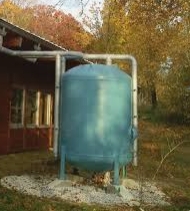 budgets to support those government initiatives, provide an environment in which WaSH projects and programs can flourish, and more.
budgets to support those government initiatives, provide an environment in which WaSH projects and programs can flourish, and more.Local, regional, and central governments play a crucial role in ensuring that donor-supported rainwater harvesting (RWH) projects are effective, sustainable, and aligned with best practices. Their roles include:
1. Policy and Regulatory Framework
-
Creating Clear Policies: Governments set clear national and local policies for water harvesting and storage, defining standards for design, construction, and operation. For example, Kenya's National Water Harvesting and Storage Strategy (2020-2025) outlines clear guidelines for rainwater harvesting infrastructure, water quality standards, and compliance requirements.
-
Ensuring Compliance: Local governments enforce regulations to ensure RWH systems meet national and international WaSH (Water, Sanitation, Hygiene) standards.
-
Inter-Governmental Coordination: Establish frameworks to coordinate efforts between national ministries, county or local governments, NGOs, private sector partners (like Rotary clubs), and communities.
-
Stakeholder Engagement: Facilitate regular meetings among stakeholders to share information, align strategies, and avoid duplication or gaps in service delivery.
-
Technical Expertise: Provide technical oversight through government engineers who supervise the design, construction quality, and safety of RWH infrastructure.
-
Capacity Building: Offer training programs for local staff on RWH system management, maintenance skills, water quality testing, and hygiene promotion.
-
Allocating Adequate Budgets: Improve staffing levels and budget allocations dedicated to water harvesting initiatives to ensure proper supervision and long-term sustainability.
-
Leveraging Donor Funds: Develop bankable project proposals to attract donor funding; clearly communicate priorities to donors based on community needs assessments.
-
Encouraging Public-Private Partnerships (PPPs): Facilitate joint ventures or public-private partnerships to leverage additional financing for larger-scale infrastructure projects.
-
Providing Technical Expertise: Assign qualified engineers or technical officers from relevant ministries (e.g., Ministry of Water) to oversee project implementation.
-
Monitoring & Evaluation (M&E): Conduct regular inspections of projects during implementation phases; establish national databases tracking RWH infrastructure performance.
-
Reporting & Transparency: Ensure regular public reporting on progress and outcomes of donor-funded projects.
-
Supportive Infrastructure Planning: Integrate RWH into county or regional development plans (e.g., County Integrated Development Plans - CIDPs), spatial planning strategies, building codes, and zoning regulations.
-
Promoting Public Awareness: Conduct awareness campaigns highlighting the benefits of RWH systems to encourage widespread adoption at household levels.
-
Maintenance Responsibility: Clearly define roles for local government departments in maintaining public RWH infrastructure alongside communities.
-
Emergency Preparedness & Disaster Management: Develop plans for emergency water supply during droughts or floods through strategic storage reserves or interconnections between systems.
-
Climate Change Resilience: Mainstream climate change considerations into planning processes by integrating RWH as a key adaptation strategy.
Kenya's National Water Harvesting and Storage Strategy (NWHSS 2020–2025) clearly outlines roles for various government levels:
-
The Ministry of Water leads policy-making, coordination, financing mobilization.
-
County governments implement local-level infrastructure projects aligned with national policies.
-
Regulatory bodies like the Water Resources Authority (WRA) ensure compliance with standards.
-
The National Water Harvesting and Storage Authority (NWHSA) oversees strategic public water works development.
This coordinated approach ensures clear responsibilities at each level of governance, fosters accountability, aligns donor funds with national priorities, enhances technical capacity within government institutions, and creates an enabling environment for sustainable water management practices.
Calgary WASH Experience
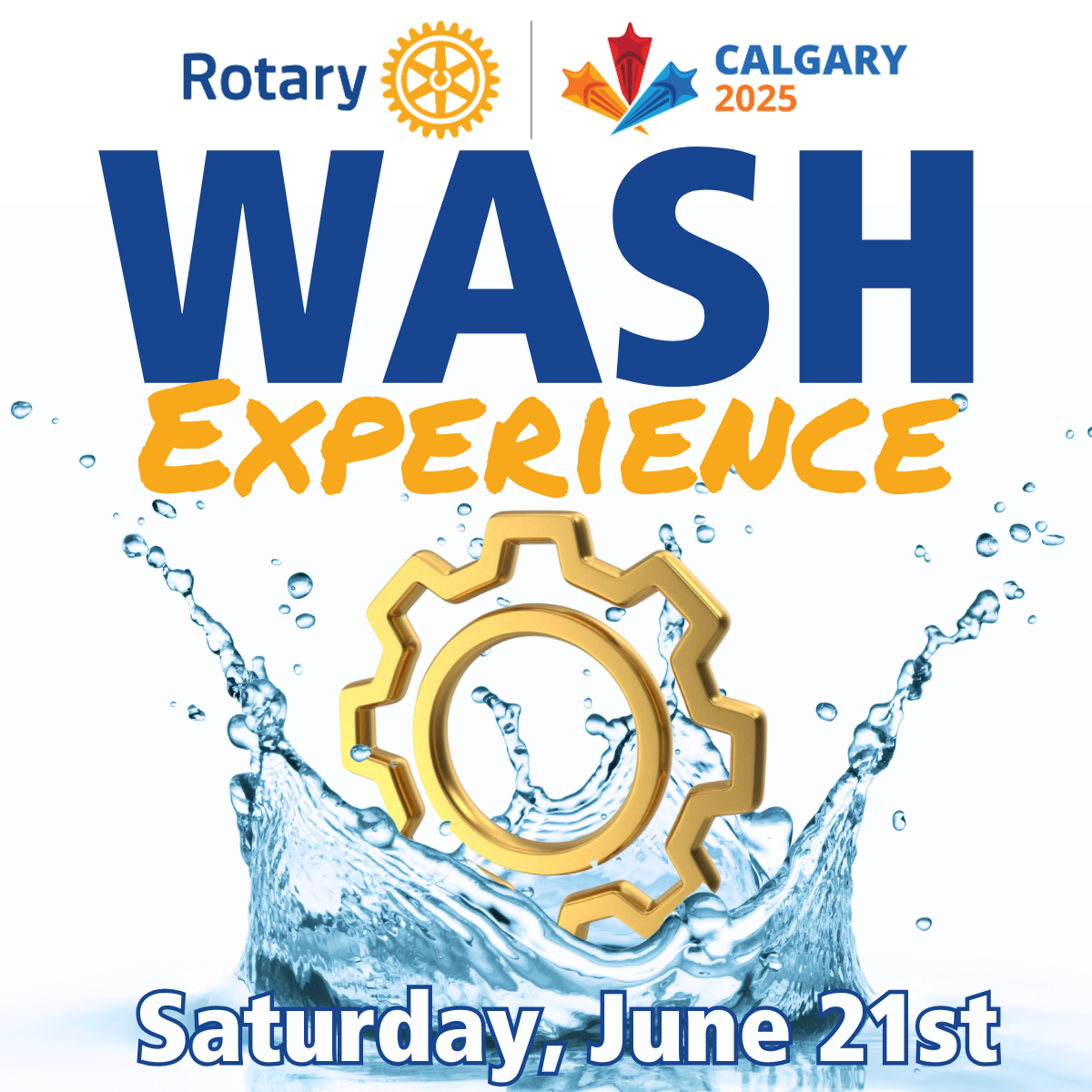 Calgary - WASH Experience
Calgary - WASH ExperienceSaturday, June 21
There will be Water, Sanitation, and Hygiene (WASH) activities during all five days of the Calgary Convention, but there will be a special WASH focus on Saturday, June 21.
World Water Summit 17
WASH Away Polio and Other Infectious Diseases
Marriott Downtown, 110 9th Avenue SE
SOLD OUT
In the House of Friendship, visit the WASH-RAG Booth 141.

Attend Ron Denham's presentation "My WASH Story" at 2:20 pm at the WASH HUB. Following Ron's presentation there will be an informal time to meet with Ron and Anna Shepherd.
At 3:30 pm in Room 224, everyone is invited to attend the WASH Ambassador Meet & Greet to learn more about the rapidly expanding Ambassador program.
WASH HUB
 Learn at the WASH HUB
Learn at the WASH HUBThe WASH HUB was a huge success last year in Singapore, and will be a focus at the Calgary Convention. It is located in the House of Friendship in the center of the WASH cluster of organizations.
You can see the list of presentations here: WASH HUB Presentations
Calendar of Events

21 Jun 2025 - WASH Ambassador Meet & Greet - Calgary
21-25 Jun - WASH HUB - Calgary
21-25 Jun - Rotary Convention - Calgary
28 Jun - WASH-RAG Annual Meeting (Virtual)
22 Mar 2026 - World Water Day
WASH Ambassador, Blessing Muderhwa, is now maintaining the Calendar on the WASH-RAG.ORG website. If you have something you want on the Calendar, send it to calendar@wash-rag.org
Sign-Up for Our Newsletter
Get news from WASH Rotary Action Group to your inbox.

Our Newsletters
- June 2025 - WASH Newsletter
- WASH Experience Calgary - May 2025
- May 2025 - WASH Newsletter
- 2025 March WASH Newsletter
- WWS17 - Feb 2025
- WASH-RAG Newsletter - February 2025
- WASH-RAG Newsletter - January 2025
- WASH-RAG Newsletter - December 2024
- WASH-RAG Newsletter - November 2024
- WASH-RAG Newsletter - October 2024
- WASH-RAG Newsletter - September 2024
- WASH-RAG Newsletter - August 2024
- WASH-RAG Newsletter - July 2024
- WASH-RAG Newsletter - June 2024
- WASH-RAG Newsletter - May 2024
- WASH-RAG Newsletter - April 2024
- WASH-RAG Newsletter - February 2024
- WASH-RAG Newsletter - January 2024
